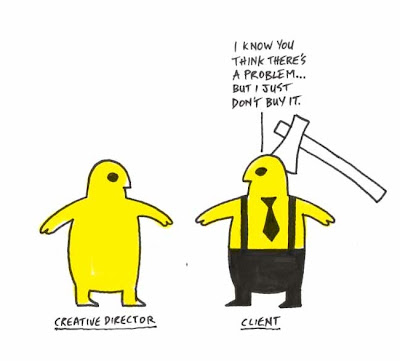Are you a good communicator or do you have the skills of a drunken scotsman, with a broken jaw, trying to speak French?
Advertising is a collaborative business. An agency only succeeds when there is partnership between the different departments and team members.
Every agency has its fair share of egomaniacs and people with an arrogant demeanor.
However, when egos clash politics become rife, e-mail wars start to erupt and ill-will starts to spread throughout the organization.
It’s important for a leader to nip politics in the bud.
When an e-mail war breaks out, approach the people involved and drag them into a room. Make them talk to each other to resolve the issue.
I witnessed a colleague of mine recently get into an e-mail war which spiraled out of control. He was unhappy at a proposal that was written from one of our divisions. It was the third revision and the proposal still wasn’t up to scratch. My colleague gave his feedback detailing the areas that needed to be improved and the gaps that needed to be filled.
It was a very concise, objective response. Unfortunately, towards the end of the letter he started to make personal comments, probably out of frustration, about the abilities of the author of the proposal.
This angered the author and he raised the issue to management. The episode caused a bit of a storm. The way the letter was written deflected attention away from what was written. Which was unfortunate. The subject matter was important in terms of getting the project on the right track and, because of the spat, it was now taking a backseat.
***
The 4 gates of speech.
On a visit to India, I was talking to Shanta Kumar, our CEO for the country, about how people communicate with each other. He told me about the 4 gates of speech, a principle his guru had taught him.
It goes like this: There are four gates you must pass through to communicate your message to another person. But to pass through the gates you first need to unlock them. And the only way to unlock them is by delivering your message in the right way. In other words, in a manner that is going to have a positive effect on the situation rather than a negative one.
To unlock the first gate, the message has to be honest.
To unlock the second gate, the message must be said in a kind way.
To unlock the third gate, the message needs to be beneficial to both parties.
To unlock the fourth gate, the message needs to be delivered at the right time.
It goes like this: There are four gates you must pass through to communicate your message to another person. But to pass through the gates you first need to unlock them. And the only way to unlock them is by delivering your message in the right way. In other words, in a manner that is going to have a positive effect on the situation rather than a negative one.
To unlock the first gate, the message has to be honest.
To unlock the second gate, the message must be said in a kind way.
To unlock the third gate, the message needs to be beneficial to both parties.
To unlock the fourth gate, the message needs to be delivered at the right time.
Although it’s philosophical in nature, I thought the advice was spot on. If you study people who do well in agencies, they tend to follow these principles instinctively. These are the people who know how to build relationships. And in the ad business that is at least 80% of the game.
***
The 4 gates of speech work especially well as a format for giving feedback to creative people.
When a creative team shows you their work, it pays to be honest with your views (gate 1). It’s the only way to improve the work.
At the same time, the feedback should not be rude, derogatory or insulting. It should be encouraging (gate 2). The job of a Creative Director is not to be a bully. It’s to be a mentor and a teacher.
The right feedback motivates and encourages people to raise the bar, which means they learn and grow. As a result, the agency gets great work out into the market place, which can only improve your reputation as a creative leader. So both parties benefit (gate 3).
Finally, giving your feedback at the appropriate moment is vital. For instance, you don’t criticize work five minutes before a pitch presentation. There’s no point. It’s too late to do anything about the work. All you’ll do is demoralize the team who will then be jaded and apprehensive in the presentation. Which is the not the state of mind that wins pitches.
The right time to give your feedback in this instance would be the day after the pitch, once all the adrenalin and excitement has died down. The feedback then becomes constructive rather than destructive (gate 4).
***
It’s not always possible to be positive with people. Sometimes you come across an art director or copywriter who is too arrogant or obstinate for their own good. The creative types that think they are incredibly talented and have nothing left to learn.
As far as I’m concerned, these people have two choices in an agency. They eat humble pie and start taking advice, or they get booted out.




















